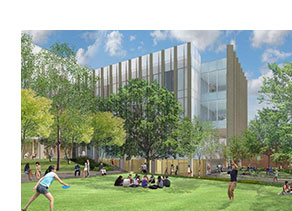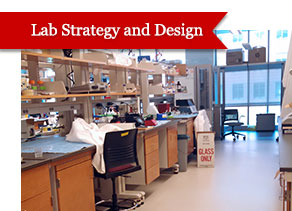Letter from the Dean of the School of Engineering
Thank you for your interest in and support of the School of Engineering at Brown. I am happy to provide you with periodic updates on the exciting progress of our new building for the School of Engineering.
The design and planning for the new engineering building continues to make great progress, and we will hold a groundbreaking ceremony on Thursday, October 22. We will host tours at 4:45 p.m., following by ceremonies on Manning Walk at 5:45 p.m. I hope you will be able to join us for this special occasion.
Our total fundraising to date has now topped $97.0 M for the School of Engineering. Thanks to all of you who have contributed so generously to this incredible project.
I am always really happy to hear from you—please reach out to me at any time.
Best,

Larry Larson
|
|
|
 |
|
|
|

About this image:
View of current design of new building from Marston Hall/Brook Street showing the vertical shading fins.

About this image:
Exterior view of new green space that will be created in front of new building and showcases the new trees that will be planted on the upper terrace to provide solar shading during the warmer months and allow sunlight in during the cooler months.
|
|
Sustainable Design Features in our New Engineering Building:
Brown University and the School of Engineering place high priority on sustainability in every aspect of our new building planning, starting with the building design, and then including the outdoor space and even the construction process itself.
As we have planned our building, we have engaged with the architects, KieranTimberlake, on integration of thoughtful sustainability elements into the building design. They have developed several innovative design elements for our new building that will help achieve greater efficiencies in heating and cooling, as well as reduce environmental impact.
Light and Shade
The building will have exterior elements designed to control solar gain through a shading system of vertical fins and horizontal shading elements. These shading fins will still allow visual continuity across the building, while being designed with nuanced adjustments in depth and geometry to meet the site-specific specific shading requirements around the building.
These vertical shading fins will be made from glass-fiber reinforced concrete, a lightweight design, made with a lower overall embodied environmental impact and lower greenhouse gas emissions. It is also considered a very durable material that will last the lifetime of the building without need for refinishing.
The placement of the new building will allow ample natural light into the new green space to be created in front of the building and along Prince Lab, while still being positioned to take advantage of shading in summer months, when solar heat gain is not desired.
|
|
|
|
|
Landscape design and stormwater strategy
A thoughtful landscaping plan around the new building supports both the reduction of water usage and stormwater runoff through the creation of rain gardens. The design incorporates a large planting area and a light roof membrane to help reduce the heat effect.
A simple but important choice of trees and strategic planting locations has resulted in a plan for deciduous trees planted on the upper terrace of the new building (facing Brook Street) to provide useful solar shading to the building in warm summer conditions and allow sunlight in during cooler winter conditions.
Stormwater management will be achieved through a combination of rain gardens, a below-ground holding tank, and sand filter bed for water quality treatment and controlled release into the municipal system.
Construction
With our project groundbreaking approaching on October 22, we have been thinking about sustainability in the construction management process ahead. The construction team is working to create a construction waste management plan to minimize construction materials sent to the landfill, with a target waste diversion rate of at least 75%.
With all of this great planning taking place, we are certainly excited about the process that lies ahead and look forward to seeing the building design take shape in the coming two years.
|
|
 |
|

About this image:
An area of particular interest during the UMass tour was flexible lab design, which was realized through innovative lab furniture and infrastructure. The group saw lab bench and storage solutions, which were set on wheels, and height adjustable for easier reconfiguration when research or new equipment requires.
|
|
Lab Planning and Best Practices at Peer Institutions:
As part of our building planning effort we have visited a number of new science and engineering buildings at peer institutions, to see firsthand what elements they integrated into their new building designs to ensure these buildings would serve cutting edge research for decades to come.
On August 7, Senior Associate Dean and Professor of Engineering Rod Beresford, IMNI Director and Professor of Materials Science Nitin Padture, Associate Dean Jennifer Casasanto, and Planning, Design, and Construction Project Manager John Cooke were invited to visit the University of Massachusetts, Amherst to view their new Integrated Sciences Building (ISB), which integrates life and chemical sciences, through flexible laboratories for research teams.
The building was designed for intensive research while still incorporating many environmentally friendly and energy-saving green-building techniques.
|
|
|
|
|
The group toured through several active labs in the ISB building to observe lab layout, lab benches and cabinetry, and shared research and equipment space. The Brown team saw how open research clusters, (with no walls between labs of similar research themes) were utilized by the UMass research groups. These labs also had shared equipment rooms which allowed for faculty to purchase joint equipment while locating it in close proximity at the edge of their labs. The Brown team was able to take in the UMass solutions for access control, and workflow, and how they have accommodated researchers of different backgrounds. All of this was of particular interest as we consider a similar open lab design for areas of our new building.
An area of particular interest was the flexible lab design, which was realized through innovative lab furniture and infrastructure. The group saw the lab bench and storage solutions, which were set on wheels, and height adjustable for easier reconfiguration when research or new equipment requires. Lab infrastructure was run through the ceilings rather than the walls or the benches, allowing for easily made connections to gases, electricity, and chilled water from nearly any point in the lab.
These opportunities to observe innovation lab solutions in use at other institutions is tremendously helpful as we begin to narrow down our lab interior design elements and make choices on what will work the best for our faculty labs and how we may best position ourselves for cutting edge research environments that will serve us far into the future.
|
|
 |
|